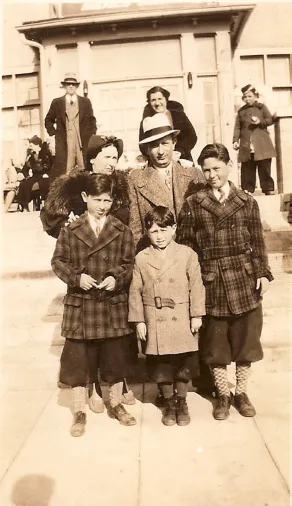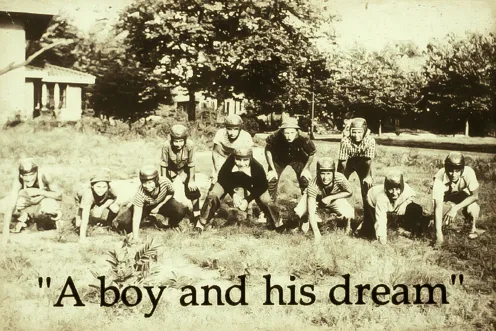![]() PART I
PART I![]()
CHAPTER ONE
Growing up in Brooklyn
A pretty rambunctious kid
New York owns a long history of international immigration. Jewish settlement there dates back to 1654, when a small group of Brazilian Jews fled Portuguese persecution and settled in what was then called New Netherlands. Unsettling times in Russia between the late 19th and early 20th centuries prompted vast numbers of Jews to depart that country, the great majority bound for New York, where by the 1950s they constituted a quarter of the city’s population.1 This massive exodus included Paul Berg’s parents, Sarah (nee Brodsky) and Harry Bergsaltz, immigrants from a shtetl in Uman, a district in the Kiev Gubernia, an administrative territorial unit in the Russian Empire.
Many Eastern European Jews threatened by growing anti-Semitic sentiments favored Kishinev, a city to which they escaped and sought work. Indeed, by the year 1900, 43% of the population of Kishinev was Jewish — one of the highest ethnic population densities in Europe. But these numbers afforded little protection from Russian hostility. During the first weeks of April 1903 (around the time of Berg’s parents’ birth), the city suffered a horrific anti-Semitic pogrom that left scores of Jews dead or severely wounded and houses and businesses plundered and destroyed.2
This tense political situation, aggravated by the constant threat of military conscription to the Russian Army, prompted droves of Eastern European Jews to leave their birthplace. The mass departure included Berg’s parents, whose odyssey took them to New York to join his mother’s half-sister, Rose (they shared the same Russian father), her husband Louis and their four children. Uncle Louis owned a horse-drawn cart and earned his living traveling from neighborhood to neighborhood peddling fresh fruit and vegetables. Notwithstanding their own hardships Rose and her husband provided much valued emotional support — not to mention financial assistance — to Paul’s parents during their long and sometimes arduous journey to America.
Harry and Sarah Bergsaltz left their homes the very day after their wedding intent on working their way to Antwerp Belgium, from whence they planned to sail to the United States. Berg’s father was just 20 years old — his mother Sarah a year younger. Three grueling years elapsed. Illegally passing through one country after another, the couple was sometimes forced to cross borders covertly. On other occasions they bribed their way to safety. In Kishinev, Harry Berg was able to ply his previously learned skills as a tailor, adding furs to hats, coat collars and full-length coats. Little is known of the details of those harrowing years except that the couple was constantly on the move, working one job after another to sustain themselves. Once in Antwerp, they boarded the vessel Belgenland bound for New York.
“It took me a long time to appreciate the enormous courage it must have required to leave their families, survive three years of wandering around Europe and eventually reach America,”3 Berg related. As if they didn’t have enough challenges to contend with, this saga was complicated by the birth of a son, Schmiel, six months before Harry and Sarah reached New York. Imagine if you can the anguish occasioned by the death of their infant not too long after their arrival in the United States — the first of two brothers in the family to die prematurely.
Once settled, Berg’s parents shortened their name from Bergsaltz to Berg. Contrary to popular belief, the view that immigration officers at Ellis Island frequently and arbitrarily changed Jewish family names has been debunked in genealogical circles.4 Officials had no cause to rely on their limited comprehension of the spelling or pronunciation of names uttered by anxious and often confused immigrants right off the ships. They were in possession of formal passenger manifests usually prepared at the port of embarkation in Europe. Furthermore, by the time Ellis Island was fully up and running in 1892, the official apparatus was vast enough to ensure no shortage of translators even for the more obscure European languages. In short, name changes during the immigration process were almost always the result of actions by immigrants themselves.5 Ellis Island immigration records document the arrival of Aron (Berg’s father), Sura (his mother) and baby Schmiel Bergzalz in New York on August 4, 1923. The family’s ethnicity is given as Russian/Hebrew and their last place of residence as Orhet, Rumania.
Harry Berg and his wife settled into a multi-family apartment house in Brooklyn, close to their newfound relatives. Harry supported his family plying his skills as a furrier, a lively trade practiced by many New York Jews. Earnings were carefully saved, and in time Berg’s father, together with a business partner, acquired sufficient resources to establish their own fur business: Kaplan and Berg — Furriers. Paul was born on the last day of June 1926, a day which his mother remembered as “absolutely scorching.”
The onset of the Great Depression seriously strained the Berg family’s meager resources. “My father was forced to work long hours to keep his business viable,” Berg stated. “He left home for work well before the sun rose. Outside of Sundays we hardly saw him before we woke and he typically returned home long after we had eaten dinner. We were not destitute or ‘poor’ then. But we certainly had to be frugal in our ways. Fortunately my mother had a genius for managing the family affairs and I don’t ever recall my brothers or I being hungry or not reasonably well dressed.”6
Berg has one living sibling, a brother, Jack, a year and half younger than he. Influenced by his older brother’s stint in the US Navy during World War II (see Chapter 3), Jack entered the US Merchant Marine Academy shortly after the war ended and graduated with a degree in marine engineering. Following active service in the Navy during the Korean conflict, Jack completed law school at night while holding down a day job in a shipping business. He subsequently cultivated a highly successful career as a specialist in maritime arbitration law, at one time serving as president of the International Maritime Arbitration Organization.
Following along the paths of his older brothers, Berg’s second brother, Irving, enlisted in the US Maritime Service as a mid-shipman at the Maritime Service Academy in Kings Point, New York. While there, he fell ill and was eventually forced to leave the Academy. He was suffering from what was ultimately diagnosed as Crohn’s disease, a serious inflammatory condition that affects the large intestine. During his short life, Irving was plagued by multiple episodes of acute intestinal inflammation that sometimes presented as medical emergencies requiring surgical intervention. For the duration of these trying times, Irving was hospitalized at Columbia University. The Berg family did not then enjoy the convenience of owning a car, hence these periods of confinement to hospital required Irving’s mother to endure four-hour roundtrips on the subway to be at her son’s side. She made these trips daily! Even when Irving was in relatively good health, Paul and Jack had little to do with the “baby” of the group. Though never really robust, in the mid to late 1930s Irving enjoyed an extended remission that supported a moderately active life, including gainful employment. But he died in his sleep at the age of 45.
Berg (front right) with his parents and his two younger brothers, Irving (front middle) and Jack (front left). (Courtesy of Paul Berg.)
The two elder siblings on the other hand, just a year apart in age, cultivated a close relationship that endures to this day.
“Paul and I were very close growing up — and remain so today,” Jack Berg related. “But he was the one who got all the girls! He was very good-looking — and a good athlete to boot and ‘went’ with two of the most gorgeous girls in the neighborhood — and had several ‘steady’ girlfriends before he and Millie became an item. I once traveled to Japan on a ship during the war and returned with a kimono for Paul’s then current girlfriend, Barbara. But when I presented him with the intended gift he informed me that he and Barbara were no longer an item — and that he had taken up again with Millie! When I was attending law school, a very attractive young woman once approached me and introduced herself as one of Paul’s former girlfriends. She asked after Paul and I told her how well he was doing. That was the expectation of everyone who knew him. That Paul would do well!”7
A distinctly laid-back personality with a confident and unflappable demeanor, Jack Berg recalled that his older brother enjoyed a lot of attention from their parents — “more so than me,” he stated diffidently. “In fact my wife frequently commented on Paul being the favored son in the family. But this sort of talk never really troubled me much.”8 By all accounts Paul’s parents were indeed unstinting in their praise of his scholastic success and personable demeanor. This attention presumably contributed substantially to the healthy measure of self-confidence he acquired at an early age, though his self-assuredness sometimes brought unwelcome consequences. Later passages will reveal some of the (frequently amusing) logistical problems that visited Berg as a result of his reluctance to seek advice from others — one presumably born of his fierce sense of independence and self-confidence.
The Berg family resided in a predominantly Jewish neighborhood in the Brownsville section of South Brooklyn where Berg’s mother maintained a kosher home — though neither of his parents were seriously practicing Jews. They spoke chiefly Yiddish (and occasionally Russian) at home. This arcane language was the first that young Paul learned to speak fluently. In fact he didn’t learn to converse in English until he attended kindergarten. “Before attending kindergarten there was nothing unusual about Jewish kids speaking Yiddish, the language that my family was most comfortable with,” Berg related. “But once I became fluent in English I remember being somewhat embarrassed that they spoke that language with a strong Russian/Yiddish accent — and not very well at that.”9
In due course, Paul’s parents moved to a four-family row house in the East New York section of Brooklyn. The family was among a minority in the neighborhood without a private telephone, relying instead on a public phone in a nearby candy store for communication. This situation offered Paul, Jack and other neighborhood kids the relished opportunity to serve as “runners” to summon those being telephoned — collecting modest tips in the bargain.
Berg’s childhood was sheltered, free of significant privations and essentially mundanely happy. Street games of all sorts quickly became one of his passions. “The neighborhood had lots of kids my age and we played roller skate hockey in the street with sewer covers serving as the goals — and basketball, with bottomless fruit baskets as basketball nets! All in all it was a very carefree time.”10 Berg’s love of outdoor games matured into one for sport in general, an enthusiasm he retains to this day. In particular, when he entered his mid-teens, he became a fervent football fan. As a young teenager he played full-bore tackle football with a local team, the Orioles, composed of neighborhood teenagers, and one which had its fair share of wins and losses!
The Orioles football team. (Courtesy of Paul Berg.)
Berg assumed much of the responsibility for keeping the local football scene alive, helping among other tasks to procure football uniforms, pads and helmets from local sporting goods stores. He avidly followed both the college and professional football scenes, his favorite college football team being that from Stanford University, known then as the Stanford Indians.
“I used to follow the progress of the Stanford team with great interest,” he related. “The team had a miserable 1939 season, losing every conference game and winning but a single non-conference game.” But the legendary college football coach Clark Shaugnnessy arrived in time for the 1940 season. That year the Stanford team was unbeaten and went on to beat Nebraska in the 1940 Rose Bowl.11 Of course Berg never then dreamed that he would one day spend Saturday afternoons enthusiastically watching the Stanford football team play in their home stadium in Palo Alto, California.
Berg’s formal education began at Public School (PS) 219, an elementary school in the East New York section of Brooklyn, an experience that he recollects as being “easy and fun.” To be sure, he skipped a grade in deference to his transparent scholastic ability. “I invariably got As for school work, but I was a pretty rambunctious kid and collected Ds for conduct,” Berg related. “So my mother was not infrequently called to school to ‘visit’ the principal.”12 But after he skipped a grade in deference to his rapid academic progress, Berg’s conduct improved and he remained at PS 219 until he completed the 5th grade.
During the late 1930s, Berg’s family spent a summer in a rented home in Sea Gate, a shore-side gated community close to Coney Island, at the tip of the peninsula that pokes out from the southern part of the borough of Brooklyn. In the early 19th century this attractive area was home to wealthy residents who established stylish summer houses and indulged their love of ocean sailing, in due course constituting the fashionable Sea Gate Association and the elegant Atlantic Yacht Club, a later stopover for sailing aristocrats. Over the years, the area underwent structural shifts that ultimately accommodated the pocket books of middle-class folks — including the Berg family. These later residents included Isaac Bashevis Singer (Nobel Laureate in literature in 1978), musician Woody Guthrie, and opera star Beverly (Bub...


